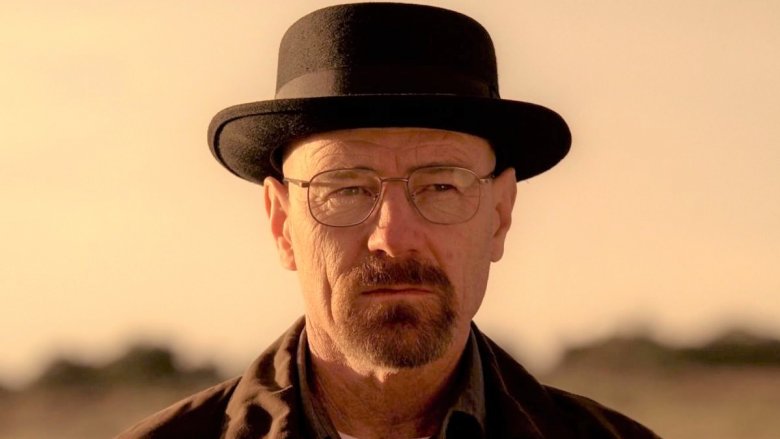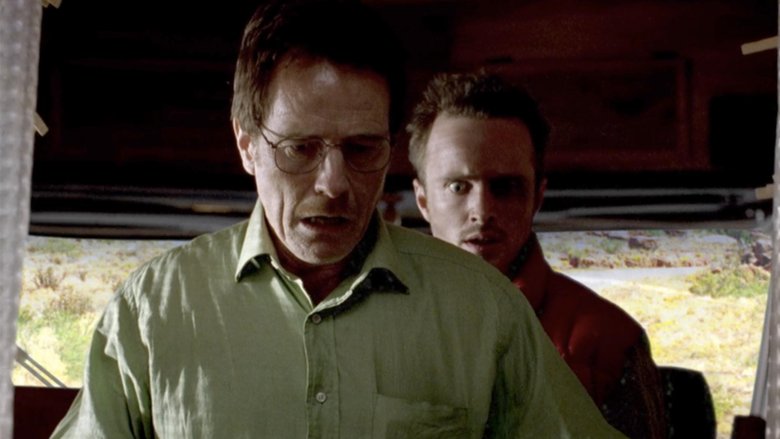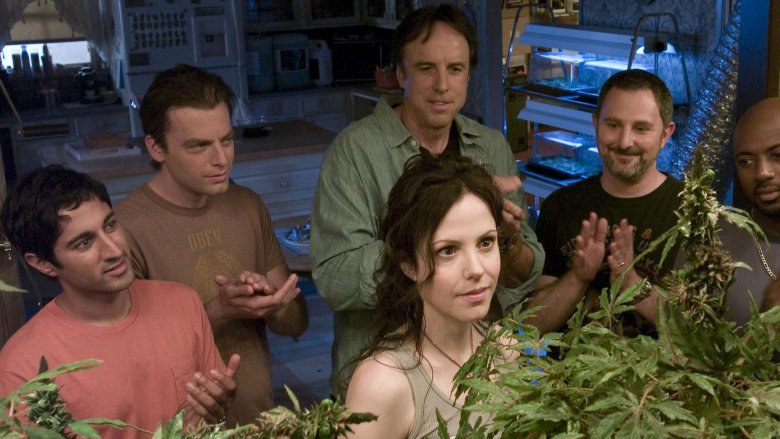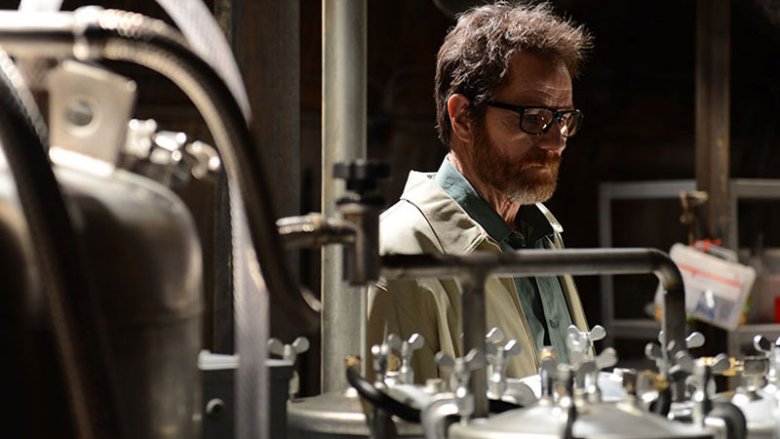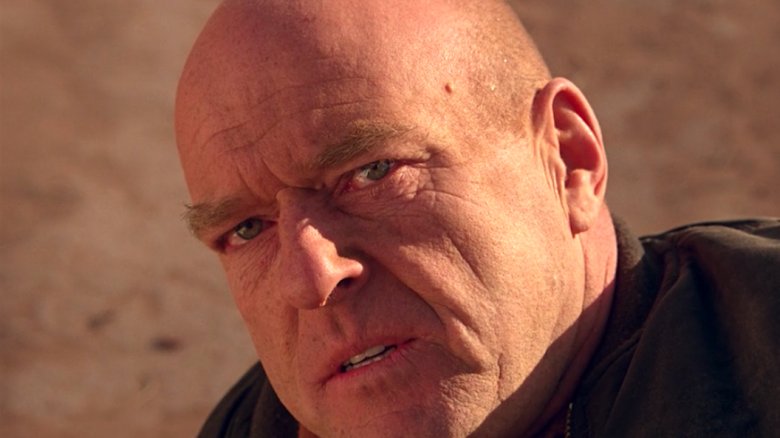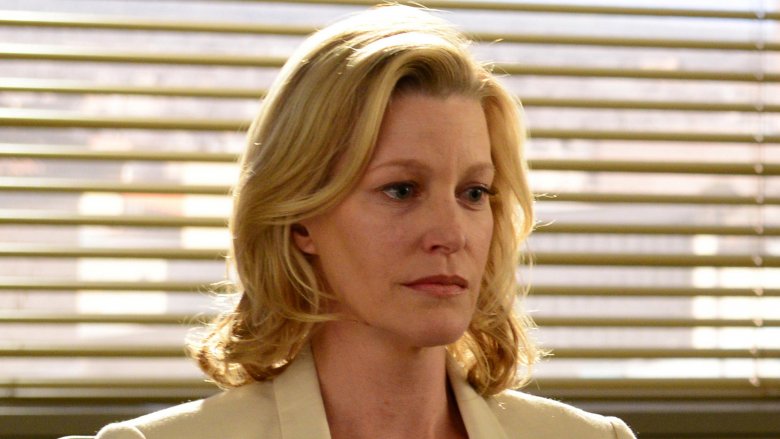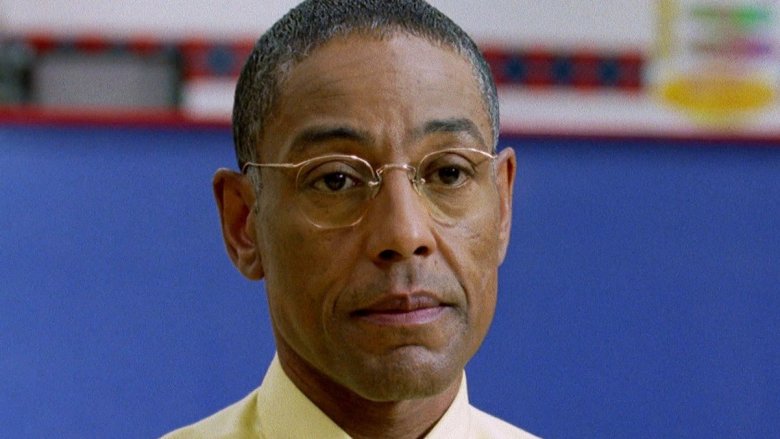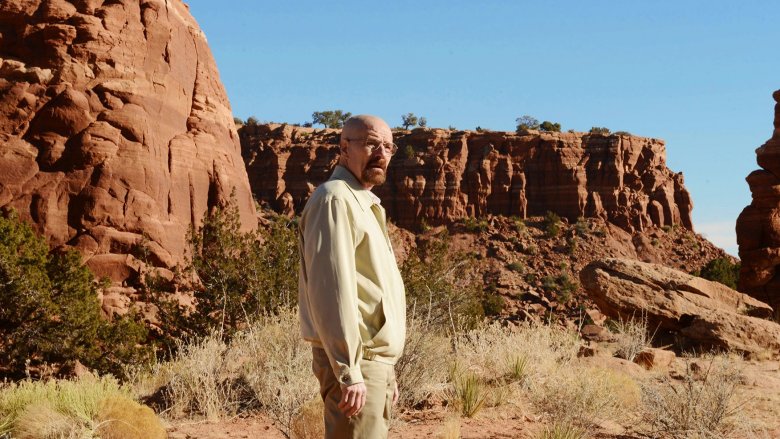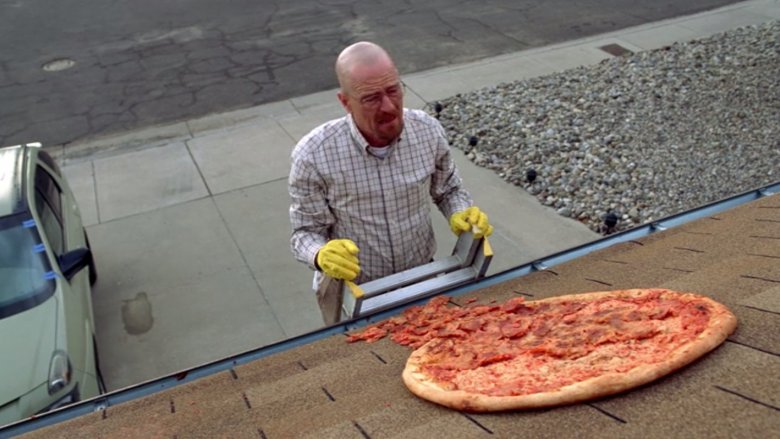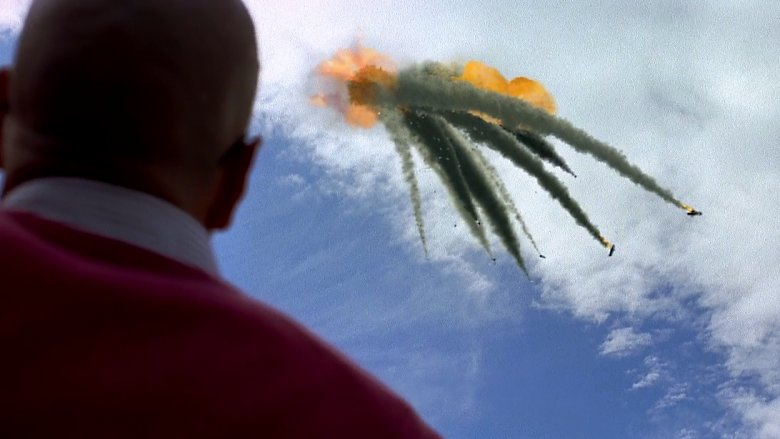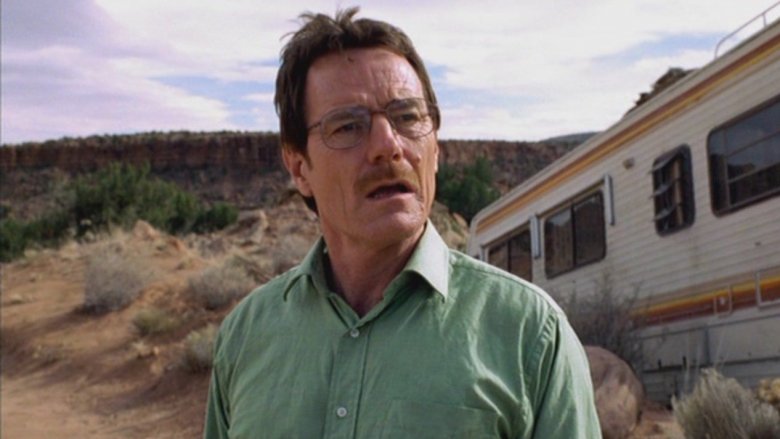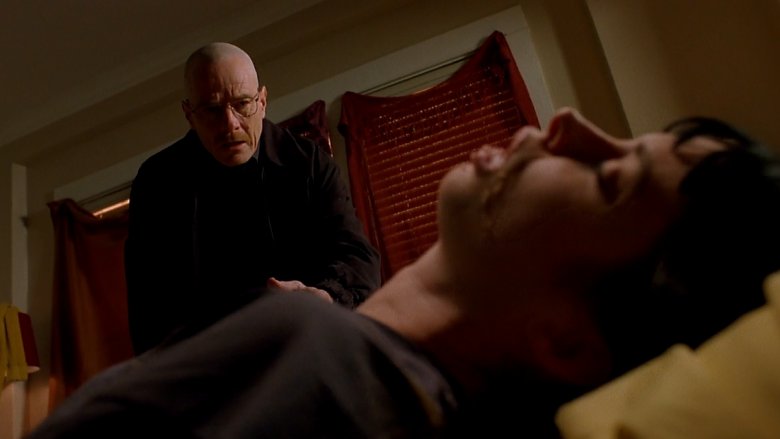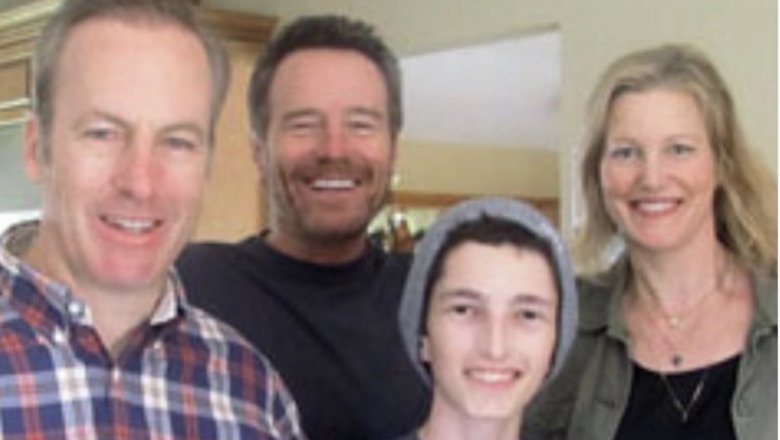What Only True Fans Know About Breaking Bad
Breaking Bad is easily one of the greatest television shows of all time, if not a stellar piece of modern American art. It features Bryan Cranston giving a performance for the ages as Walter White, a sad-sack high school teacher who finds out he has cancer. Worried about what will happen to his family if he should die, Walt uses his chemistry skills, a beat-up RV, and the help of a ne'er-do-well former student to cook up the best (and bluest) meth in all of New Mexico.
But hey, everybody knows the plot to Breaking Bad. That's no secret. Of course, just like at the counter of Los Pollos Hermanos, there's a whole lot going on behind the scenes of this award-winning show. And if you want to go from being a mere fan of the series to a hardcore Heisenberg, then it's time to get cooking. From shocking character choices to the show's lasting legacy, here's the stuff that only true fans know about Breaking Bad.
A ton of networks passed on Breaking Bad
Once primarily a repository for old movies, AMC launched Mad Men in 2007 and Breaking Bad in 2008, positioning itself as a major "peak TV" player alongside the likes of TNT, HBO, and FX. Oddly enough, all those networks turned down Breaking Bad. "The two executives who I pitched it to were on the edge of their seat, they were loving it," creator Vince Gilligan told the Television Academy Foundation about his TNT experience. At the end of his breathless description of the first episode, the suits "[looked] at each other, and they [said], 'Oh, God, I wish we could buy this.'" Evidently, they were scared off by the fact that Walt cooks meth, so they "half-heartedly" asked Gilligan if he could make him "a counterfeiter instead. (No dice.)
While Gilligan says the HBO executive he met with "could not have been less interested," FX actually bought the series, only to reverse course. "We had three dramas with male antiheroes," FX president John Landgraf told KCRW's The Business, referring to mid-2000s hits The Shield, Rescue Me, and Nip/Tuck. "The question was, are we defining FX as the male antihero network, and is that a big enough tent?" According to E! Online, FX decided to branch out and greenlit the Courtney Cox drama Dirt, instead. After all these rejections, things were looking bad for the show. "It was dead as a hammer," Breaking Bad creator Vince Gilligan told The Hollywood Reporter. As a last resort, his agent sent it to AMC, which was looking to expand its original programming slate. And the rest, as they say, is history.
The creator almost got caught up in the Weeds
In addition to TNT, HBO, and FX, Vince Gilligan pitched Breaking Bad to Showtime in 2005. Gilligan later recalled to Newsweek being "about five minutes" into his presentation when the network president quipped, "'This sounds a lot like Weeds.'" Gilligan hadn't heard of Weeds, so he asked what that was, and the executive explained that it was a brand new Showtime series about a mild-mannered suburban mom (Mary-Louise Parker) who, facing a financial emergency, starts selling drugs.
That's a premise very similar to Breaking Bad's. "I could feel the blood drain from my face," Gilligan said. Two representatives from Sony Television were there with him, and he asked if they knew about Weeds. They had, but they told Gilligan that Weeds and Breaking Bad were "completely different," like "apples and oranges." (Or marijuana and meth, as the case may be.) Gilligan briefly considered abandoning Breaking Bad altogether, but ultimately, he trusted the Sony reps. And it's a good thing that he wasn't familiar with Weeds. "If I had known of Weeds weeks or even days prior to that meeting," Gilligan said, "it's likely I wouldn't have had the will to go on."
Inside the Breaking Bad finale
The final episode of Breaking Bad aired in 2013, wrapping up five seasons in a way that gave closure to its main characters. As you probably know, the show ends with Walter White dying among his laboratory equipment to the strains of Badfinger's "Baby Blue," and with Jesse Pinkman (Aaron Paul) escaping his life as an enslaved meth cook for Nazis. That episode was titled "Felina," which just so happens to be the name of the idealized young woman in the 1959 Marty Robbins story-song "El Paso."
That particular song, a country music classic that hit number one on Billboard, actually makes an appearance in the episode, and the tune concerns an outlaw on the run who returns to "the badlands of New Mexico," where he committed a grievous crime. Hey, you know who else committed some serious crimes in New Mexico? Walter White of Breaking Bad. Plus, in two strokes of wordplay genius, "Felina" is an anagram for "finale," and it can be broken down into three chemical symbols: Fe, Li, and Na. Those represent iron, lithium, and sodium ... which just so happen to be vital ingredients in blood, meth, and tears. In other words, "Felina" is what Breaking Bad was all about all along.
Is Breaking Bad a comedy?
While "dramedies" — ostensibly serious shows laced with comedy, such as Transparent and Orange is the New Black — have been enjoying their moment for a while, Breaking Bad is not that kind of genre-buster. It was an extremely serious show. There's not much humor to mine in the story of a man who descends into darkness (and takes a lot of people with him) when he becomes a drug lord in order to pay for cancer treatments and prevent financial ruin for the wife and two kids he'll leave behind. The closest thing the show had to comic relief was Dean Norris's work as obnoxious, cocksure DEA agent Hank Schrader. And that all stems from Norris's confusion over how to play the role at his Breaking Bad audition. "I was, like, conflicted. I was like, this is funny to me," Norris said on Conan, adding that his agent explicitly told him that the show was a drama. "So I was like, 'No, I'm gonna go with my gut and make it funny.'"
Skyler White made it out alive
A lot of Breaking Bad characters die in horrible ways. Walter White dies, Hank Schrader dies, Gus Fring dies, and Jane Margolis dies, to name a few. In fact, creator Vince Gilligan nearly killed off Jesse Pinkman in the first season, and he proposed offing Skyler White (Anna Gunn) near the end of the series.
He came up with the idea that Skyler would go with her husband and the Disappearer (Robert Forster) on their hideout trip to New Hampshire after all hope is lost. "We talked about a possible version where Skyler and Walt are tied up at a Motel 6 kind off place, and he's talking to her in a bathroom saying, 'It's going to be alright ... I've got a plan.' And he finally forces the door open, and she's in a bloody tub or something like that," Gilligan said on the Breaking Bad Insider podcast (via IndieWire). The writers dropped the idea because of the Walt Jr. factor. "We could never figure out how to get Junior to go along," Gilligan said. "There's no bringing him if he doesn't want to go."
When the bad guy goes, you gotta get Gus
As masterfully portrayed by Giancarlo Esposito, Gus Fring is among the most fascinating (and complicated) villains in TV history. He runs his meth smuggling business with cruelty, while never losing his dignity, fastidiousness, or letting his drug empire interfere with his successful front, the fast food place Los Pollos Hermanos. Gus' rise and fall is crucial to the series' arc and Walter White's transformation, but he surprisingly wasn't originally part of Breaking Bad creator Vince Gilligan's plan.
By early season two, frightening drug kingpin Tuco Salamanca served as the series' "big bad," a factor Gilligan wanted to explore for a while. However, the actor who played him, Raymond Cruz, had to bow out. "He had prior commitments after the first episode on a TV show called The Closer," Gilligan told Digital Spy. "So he became unavailable to us, and we thought, 'Man, we're never gonna have a character as good and interesting as he was,' but we then thought to ourselves, 'Why don't we go in the completely opposite direction?'" And that's how they decided to create a villain who was a "buttoned-down, cold-blooded, soft-spoken businessman." And thus, you get Gus.
A right turn at Albuquerque
Setting (and filming) Breaking Bad in and around Albuquerque, New Mexico, gave the show a vast and beautiful desert landscape where all sorts of criminal activities could go on unnoticed. But it also presented an "Everytown USA" dynamic to contrast with the dark journey of Walter White. It wouldn't have been the same show were it set somewhere else ... and it almost was.
In the 1990s, Riverside, California, earned a reputation as one of the U.S.'s most active meth turfs, and that's where Vince Gilligan initially set his series. "I intended to set it in Riverside," Gilligan told Slant (via the The Press-Enterprise). "When I originally conceived of the show, I wasn't thinking as much in terms of the Mexican drug cartel component. I was thinking more in terms of a homegrown meth business that Walter White was going to establish." Studio Sony Television suggested to Gilligan that he change Riverside to Albuquerque because the show would be cheaper to shoot there, owing to tax breaks for TV productions.
Just stay off the roof, okay?
Breaking Bad fans love to visit the real-life locations depicted on the show. (There are even guided tours.) One of the most sought-after locales is the Whites' humble home, although the people who live in and near the house used for exterior shots are over it. "All day, non-stop, there's people up and down this road. They park in front of our driveway and block us in," a neighbor told Albuquerque TV station KRQE (via Entertainment Weekly). The residents of the White house got so tired of gawkers — and fans who stole rocks and other garden items as souvenirs —that they ordered construction of a six-foot-tall iron fence. "They feel the need to tell us to close our garage, get out of the picture, you know — tell us what to do on our own property," Joanne Quintana told Albuquerque's KOB.
Building a fence also put to an end once and for all to another intrusive fan activity, which involved re-enacting a moment from a third season episode when an angry Walter White throws a pizza on the roof. In 2015, Breaking Bad creator Vince Gilligan implored fans to stop. "There is nothing original or funny or cool about throwing a pizza on this lady's roof," he said on the Better Call Saul Insider podcast. "People live in these houses."
There's a secret mini-show hiding in plain sight
An "Easter egg" is hidden throughout the second season of Breaking Bad. Four non-consecutive episodes open with ominous, black-and-white "teaser" clips, seemingly unconnected to the show. But string those four segments together, and they form a cohesive whole, depicting a plane crash and its aftermath. And when the titles of the episodes featuring those clips are similarly placed together, in order, they form a sentence: "Seven-Thirty-Seven," "Down," "Over," "Albuquerque."
Breaking Bad creator Vince Gilligan told NJ.com that he and his writers "worked very hard" to come up with episode titles with "proper dual meanings." On the surface, "Seven-Thirty Seven" refers to the $737,000 Walter wants to leave behind for his family. "Down" is about Jesse being "down and out." "Over" concerns Walter thinking his drug-making days are finished. And "ABQ" is an abbreviation for the show's central location of Albuquerque. Season two wraps up with a plane crashing in Walter's backyard — a 737 down over Albuquerque. "In simple terms, we just wanted a giant moment of showmanship to end the season," Gilligan said. "And what better way than to have a rain of fire coming down around our protagonist's ears, sort of like the judgment of God?"
The clothes make the man
The central through-line of Breaking Bad is pretty easy to ascertain. Walter White, once a regular family man with a regular job as a high school teacher, slowly turns wicked as he becomes more embroiled in the manufacture and distribution of methamphetamine, doing whatever he can to stay alive, free, and on top of the game. That's all very literary, but television is a visual medium, and Breaking Bad expresses its arcs visually, if subtly. In an article for TDYLF (via Slate), graphic designer John LaRue posits that the characters' trajectories can be tracked by the colors of clothes they wear over the course of the show.
Marie Schrader (Betsy Brandt) loves purple and wears it a lot, but "it's the very rare occasions when she's not wearing purple that practically scream at the viewer," La Rue writes, pointing out the black she sports during a kleptomania relapse. Walt Jr. (R.J. Mitte) apparently wears colors that indicate support for other characters. He's in purple when Marie is in a difficult spot, for example. Skyler White "starts out blue," but her palette turns dark when she gets wise to her husband's other life. As for Walter White, he wears "drab khaki" after bad cancer news or a personal setback, but when he gets more involved with Gus Fring, more blue shows up in his wardrobe, a nod to his signature blue meth.
The truth behind Jane's death
Of all the horrible things Walter White does in Breaking Bad, the very worst may be letting Jane die. Portrayed by Krysten Ritter, Jane is Jesse Pinkman's recovering addict girlfriend, whom he pulls back into the world of drugs. She dies after asphyxiating on vomit after an overdose. Walter witnesses the death, and while he could save her, he allows her to perish, because it's more advantageous to him in his dealings with Jesse.
It's a dark moment, and it was almost darker. As part of the Tribeca Talks series (via IndieWire), Cranston explained that in earlier drafts of the script, Jane "starts to cough and she's on her side, and Walt looks at her, and pushes her shoulder so she's on her back — essentially killing her." AMC and producer Sony Television objected to that bit, not because it was too awful, but because it would mean Walt would "break bad" too soon.
That still represented an acting challenge for Cranston. When Ritter shot the vomiting scene, Cranston said that Ritter's face "lost all characteristics, and out of that came the face of my real daughter choking to death." The actor added that even years later, he still gets "a little choked up about it."
A true fan changed the course of Breaking Bad
Breaking Bad's fifth and final season premiere hit AMC on August 11, 2013, ending with the on-screen message, "Dedicated to our friend Kevin Cordasco." That's the name of a Breaking Bad mega-fan who died earlier in the year after a long fight against cancer. "He and his friends watched it obsessively and ate pizza in his bedroom," Kevin Cordasco Sr. told The Hollywood Reporter. "There was something about the Walter White character ... the way he took control of his illness, and his life, that really resonated with Kevin."
As it turns out, Cordasco's godmother set up a cast visit. She called up a talent agent friend who worked with the wife of an executive at Sony Television, Breaking Bad's studio. That exec called Bryan Cranston, and not long after, the kid got to meet his favorite TV character. "Bryan and his wife sat with Kevin for hours at the hospital," Cordasco Sr. said, adding that show creator Vince Gilligan "came to our house, along with some of the cast."
Gilligan told the Breaking Bad Insider podcast (via Forbes) that he asked Cordasco if there was anything he'd like the show to explore. His reply? "I want to know more about Gretchen and Elliott." That's the couple who, with Walter White, formed Gray Matter. Walt left the company early on, before it made billions. Thanks to Cordasco, Gretchen and Elliot reappear in season five. Walter rejects their offer to pay for his treatment, meaning he keeps making meth because he likes it, not out of need.
